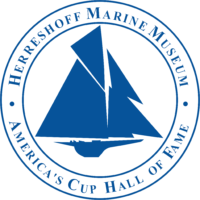April 2, 2021
The Origin of the America’s Cup Hall of Fame
To continue the celebration of the Herreshoff Marine Museum's 50th anniversary, Steven Tsuchiya takes us back to the founding of the America’s Cup Hall of Fame in 1992.
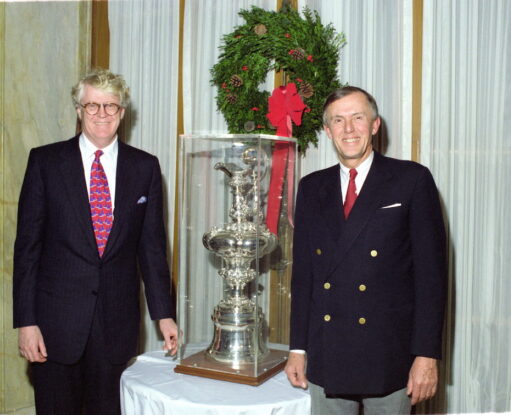
by Steven Tsuchiya, Chairman of the America’s Cup Hall of Fame Selection Committee
On the snowy evening of December 13, 1992, at Marble House in Newport, Halsey Herreshoff, the president of the Herreshoff Marine Museum, announced the establishment of the America’s Cup Hall of Fame and the names of the eighteen charter inductees to nearly 500 guests. That historic evening featured remarks in support of the Hall of Fame by America’s Cup veterans Rod Stephens, Elizabeth Morss Hovey, Ted Hood, and Bill Koch. The Governor of Rhode Island and the Mayor of Newport voiced their enthusiasm for it as well.
On display in the house’s Gold Room that night was the object that all the inductees of the Hall of Fame have devoted a significant portion of their lives in pursuit: the America’s Cup, the Holy Grail of yachting. The Cup was flown in from San Diego (the San Diego Yacht Club being the holder of the Cup at that time). But due to a blizzard, the plane couldn’t land at its original destination, Providence. Instead the plane was forced to land in Hartford, Connecticut. Halsey Herreshoff managed to have the Rhode Island State Police beg the Connecticut State Police to escort the priceless trophy from Hartford via the roads to Rhode Island. Halsey recalls, “So late in the evening, the Connecticut police conveyed the Cup to the our state police and myself. And I said to the state policemen, ‘What are we going to do with this for the night? Because I don't want anything to happen to the Cup.’ So I said, ‘Is it possible, could we put it in one of your jail cells, maybe?’ They replied, ‘Sure, that's a good idea.’ So we opened up a jail cell and put the America's Cup in it and locked the door for the night. I think I have the distinction of being the only sailor that ever put the America's Cup in jail!”
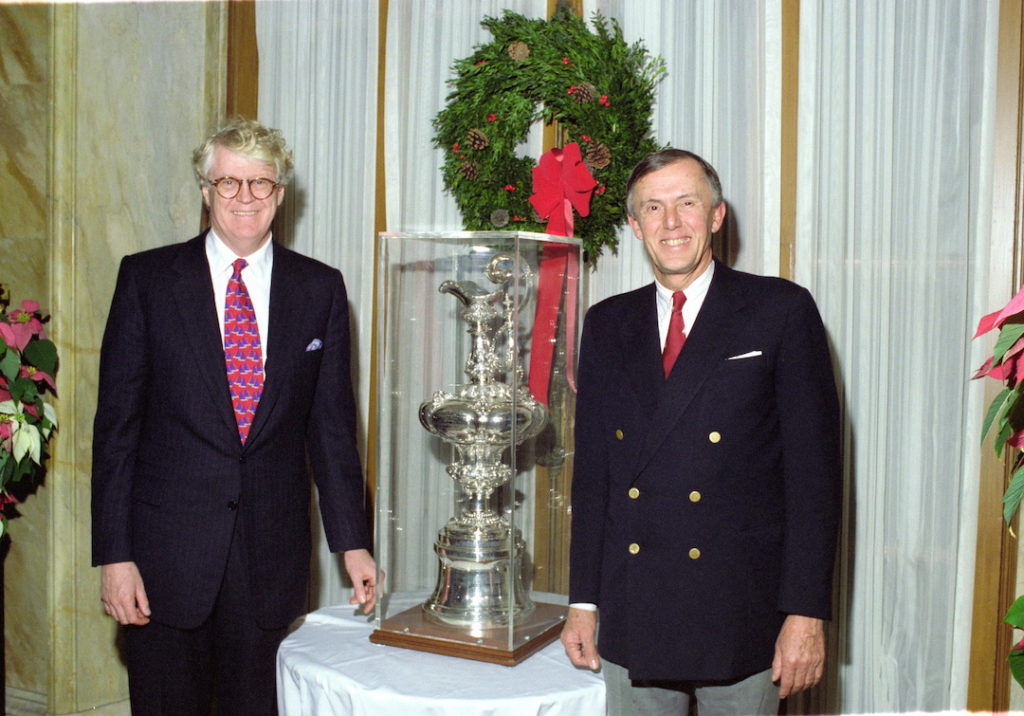
Halsey Herreshoff, the grandson of the legendary designer Nathanael G. Herreshoff and, himself, a three-time Cup winner during the 12-Metre Era, was the founder of the Hall of Fame.
Halsey is often asked how it got started and why. He reflects, “In those many years when I raced on America's Cup defenders, 12-Metre boats at Newport, we would often end up—after either a practice race or an America's Cup race—many miles off of Newport. And we would have to tow the yacht back in. So we, in those cold afternoon or evenings, we would huddle in the cockpit and talk about all kinds of things, what we all wanted to do after we got through sailing and what it meant to be there. And one of the topics that arose frequently was, it was great that the America's Cup had been restored in 12-Metre boats, but it only happened every three or four years, and in between, there was nothing. So the thought of all of us was, ‘There ought to be some kind of an organization that bridge the gaps between each of the contests.’”
Nothing came of fulfilling that idea until after the New York Yacht Club lost the Cup in 1983. Throughout the 1980s, Halsey revisited the concept but it was not until late 1991 or early 1992 that it finally took traction. Halsey recalls that he was encouraged by two friends, Ken Dooley, who was then working for the Museum, and Edward I. du Moulin, who was the manager of Dennis Conner’s 12-Metre era Cup campaigns. Halsey said that Ken “was very important because he moved me from good idea into action.” Ed, in full support of the plan, helped Halsey execute the strategic vision of the idea.
Halsey recounts, “When we came up with the idea of fulfilling that dream of a permanent organization for the America's Cup, it seemed to me that we didn't need to emphasize the yachts, and we probably didn't need to emphasize the races totally. But I'd always been very much impressed by the Baseball Hall of Fame in Cooperstown, New York. So we said, ‘Why don't we have this organization be a Hall of Fame to honor those who have been significant in the racing, designers, builders, skippers, crewmen, managers?’”
Halsey, along with Ken and Museum curator Carlton Pinheiro, subsequently visited the Baseball Hall of Fame in Cooperstown to learn details of its design and administration.
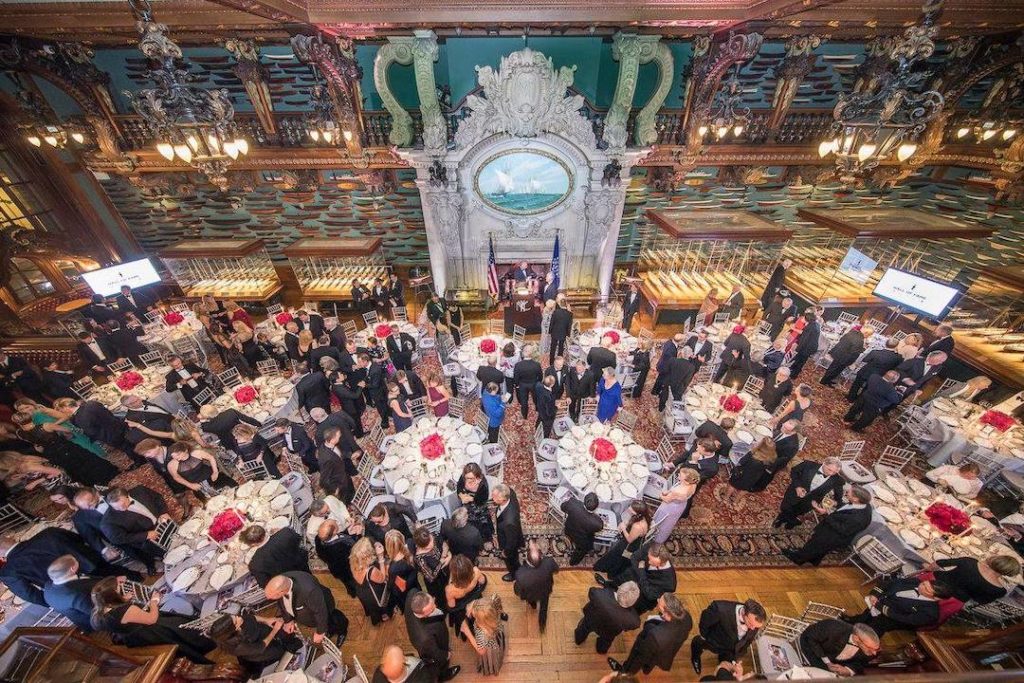
As in the formation of any new organization, the development of its prerogatives and its rules are vital. According to Halsey, “the star of that process was Ed du Moulin, who, like me, had a great devotion to the Cup.” Ed developed, with input from Halsey, a protocol of which the most important feature was the criteria for selecting inductees.
Halsey states, “One of the important things, of course, in the Hall of Fame is who you select to be in it. And we see this in baseball, football, basketball, and all that. And we had the same dilemma of how we would develop a criteria for honoring a person to be a member, and how we would go about the selection process. We thought that the basis should be those who were significant in America's Cup races and in the perpetuation of the Cup itself. And, so, that would involve all kinds of people, designers, builders, owners, syndicate members, great skippers like Charlie Barr. We didn't really care whether they were amateur or professional because the first amateur skipper was actually Charles Francis Adams in 1920, previous to that, the skippers were all professional sailors. So we thought what mattered was the quality of the individual and the significance of what he did.”
But some disagreed about inducting professionals: most notably, Bus Mosbacher—former New York Yacht Club Commodore and two-time Cup winner. Dave Guertin of the Herreshoff Marine Museum, then only 22 years old, tells the story of the issue:
Halsey and Ed had participated in the transition from amateur sailors to professionals in the America’s Cup, and this was a heated topic for many of the old guard. Thus the call to Bus Mosbacher to request his endorsement of the Hall of Fame took a hard jibe when Bus firmly cautioned about inducting professionals.
This challenge was significant enough to warrant a dinner discussion at the Griswold Inn in Essex, Connecticut marvelously hosted by Bill Winterer, with the titans of the 12-metre era: Olin and Rod Stephens, Bob McCullough, Ted Hood, Victor Romagna and Bus Mosbacher. I was seated between Vic and Bus.
Bus’ argument against the professionals was firm, and Vic could tell that Bus had effectively scared me—the young messenger between the titans and the team of Halsey and Ed—to near death. Vic pleaded to Bus that young people like me (but certainly not me) could never take the time from their careers to compete in the Cup, regardless of the honor, and Bus could not change the course of the America’s Cup as a modern venture. Bus was won over.
Looking back, at the seating arrangement, prepared by the masterful Ed du Moulin, perhaps only Vic was capable of convincing Bus given their decades-long trust in each other since the days when they raced together on WEATHERLY, the 1962 Cup winner.
In the beginning, there was concern about the Hall of Fame’s mission and its ability to carry it off—most notably expressed by the Board of Trustees of the New York Yacht Club. The Club’s commodore, Charles M. Leighton, invited Halsey to make a presentation and take questions at a Trustee’s meeting at Harbour Court. Evidently, the Hall of Fame’s concept, with its careful respect for tradition, was deemed acceptable. Since then, Commodore Leighton and succeeding flag officers have been supportive of the Hall of Fame. It also garnered similarly gratifying support by other clubs, including the Royal New Zealand Yacht Squadron, the current holders of the Cup.
In the summer and fall of 1992, with the foundation established, Halsey, with consultation with Ed du Moulin, selected the first class of inductees, the “charter class”:
- George L. Schuyler
- Nathanael G. Herreshoff
- Captain “Charlie” Barr
- Sir Thomas J. Lipton
- Charles Francis Adams
- Harold S. Vanderbilt
- Gertrude Vanderbilt
- Olin J. Stephens II
- Roderick Stephens Jr
- Emil “Bus” Mosbacher
- Briggs Cunningham
- William Ficker
- Robert N. Bavier Jr
- Ted Hood
- Ted Turner
- Dennis Conner
- John Bertrand
- William Koch
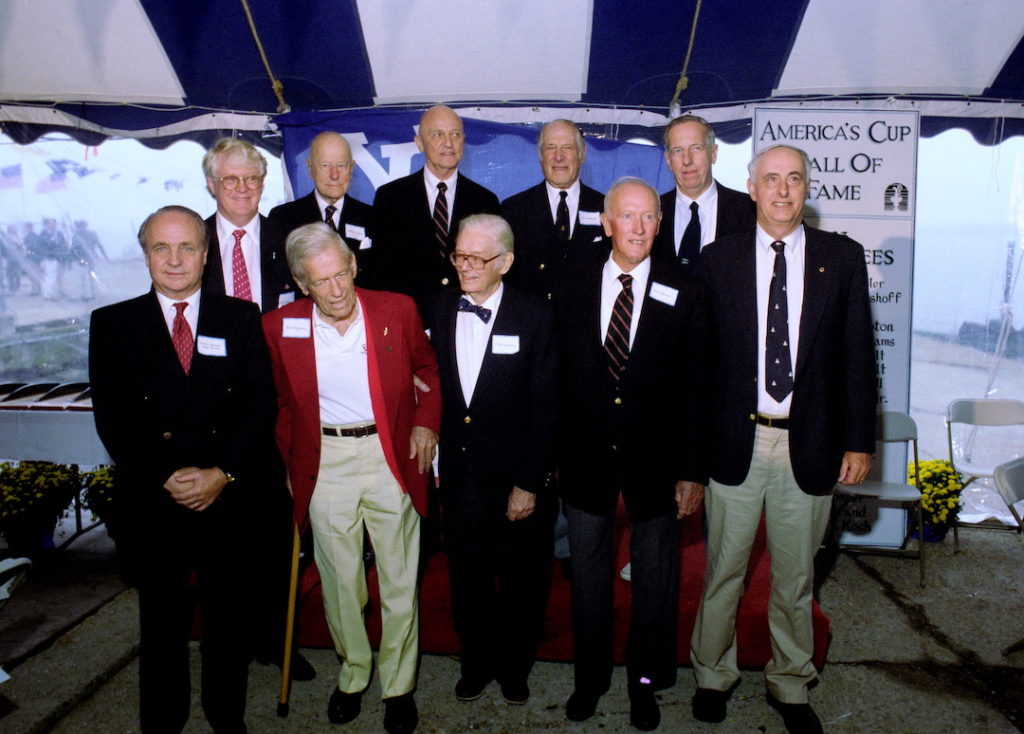
But going forward, Halsey and Ed decided to form a Selection Committee of twenty-two individuals to evaluate and elect future classes of inductees. By early December 1992, they formed the first Selection Committee. The committee included prominent New York Yacht Club members such as Commodore Harry Anderson, Devereux Barker III, Elizabeth Meyer, C. Thomas Clagett, Jr, Ed du Moulin, George F. Jewett, and others. It also included chroniclers such as the yachting historian John Rousmaniere and journalists, John Burnham and Dave Philips. Former Cup sailors were part of the committee too, including, Gary Jobson, Vic Romagna, Bruno Bich, Gordon Ingate, and Jack Sutphen. Of the original members, Barker, Meyer, Burnham, and Jobson remain on the committee to this day.
The decision to locate the Hall of Fame at the Herreshoff Marine Museum was an easy one: the Herreshoffs of Bristol built an unprecedented eight consecutive successful Cup defenders; Rhode Island was the location most closely associated with Cup races in the United States; and the infrastructure to hold it was already there—the Herreshoff Marine Museum, founded in 1971.
In September 1993, the charter members of the Hall of Fame were inducted at the Herreshoff Marine Museum. It was the most extensive gathering of America’s Cup legends ever brought together until it was eclipsed by the America’s Cup Jubilee in 2001.
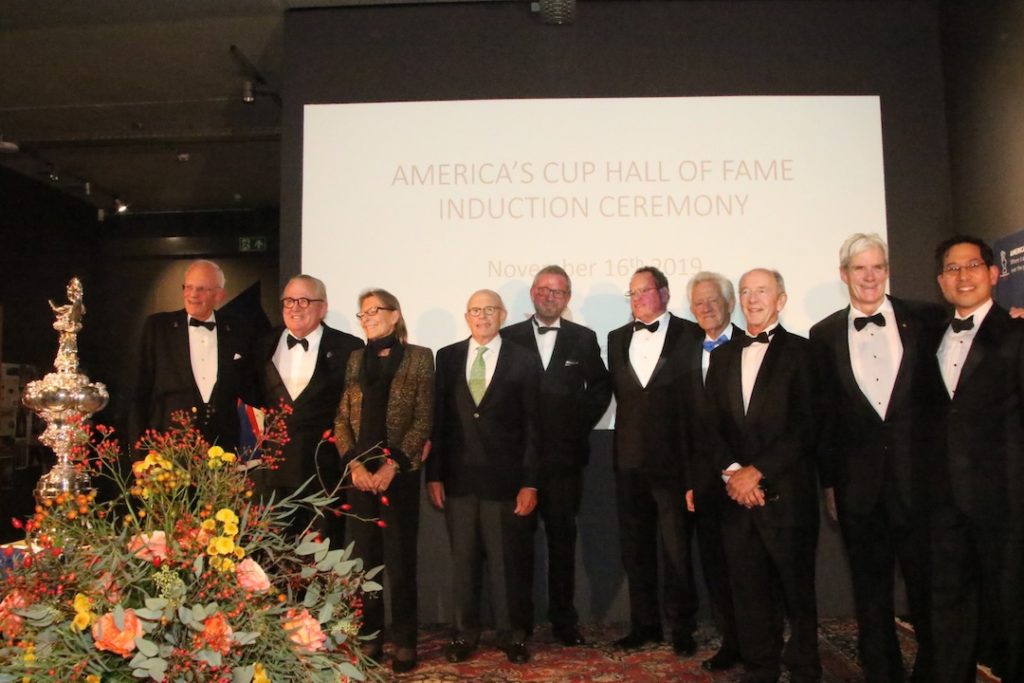
Three decades on, the America’s Cup Hall of Fame is going strong and has achieved great stature in the America’s Cup world; many inductees proudly refer to themselves as “Hall of Famers” and the Induction Ceremonies have taken place at many places around the world including, Bristol, Newport, Cowes, Auckland, New York, San Francisco, Valencia, and Flensburg.
On March 19th, the Hall of Fame enshrined the 94th and 95th inductees, Ed Baird and Peter J. Montgomery, at a ceremony at the clubhouse of the Royal New Zealand Yacht Squadron in Auckland.
